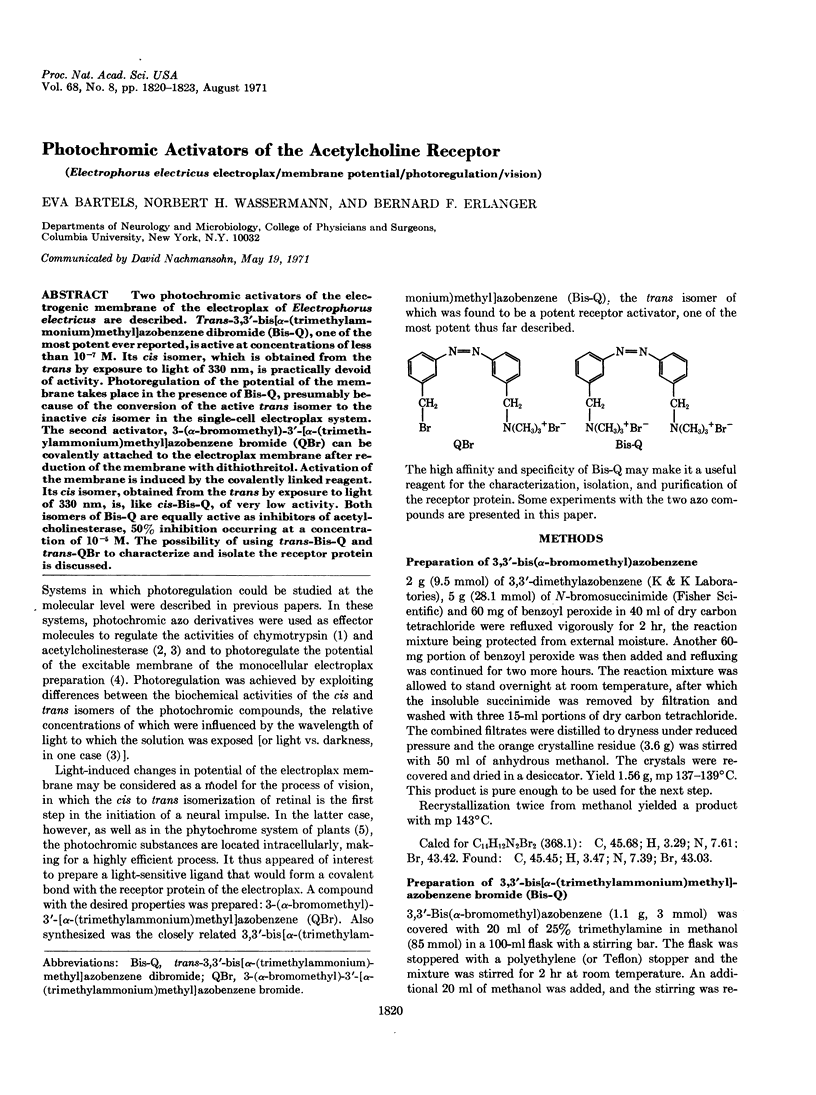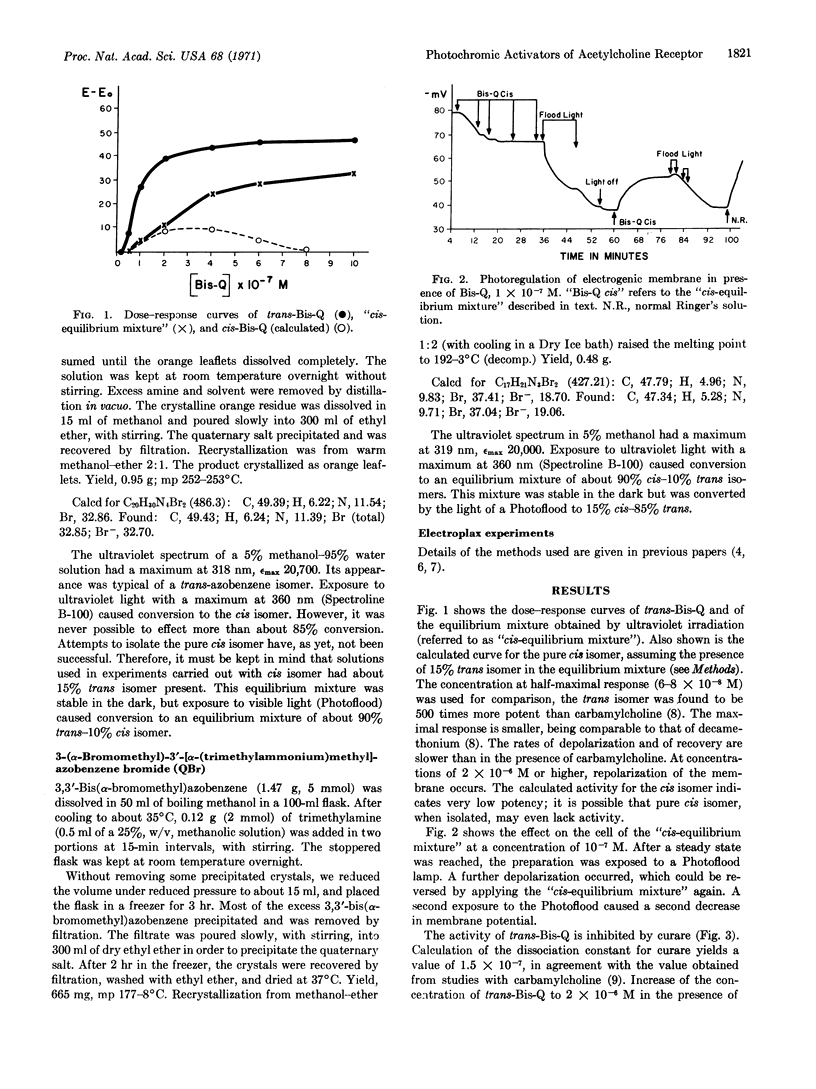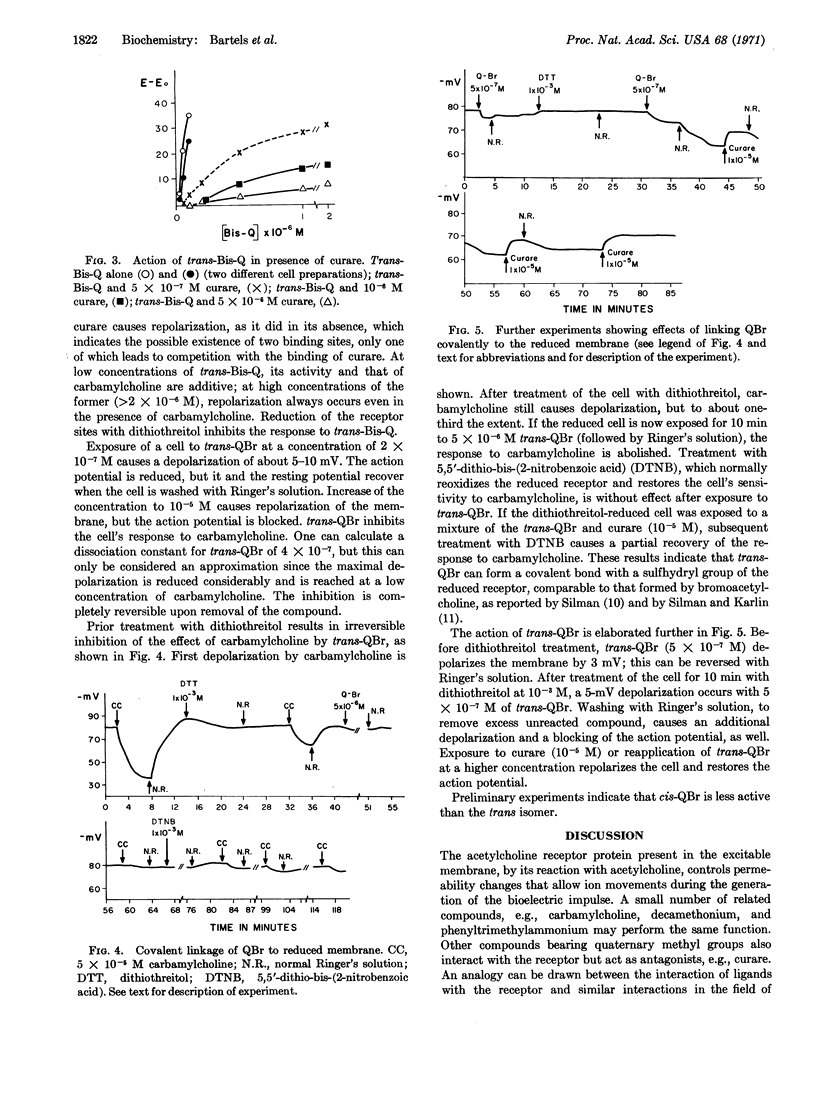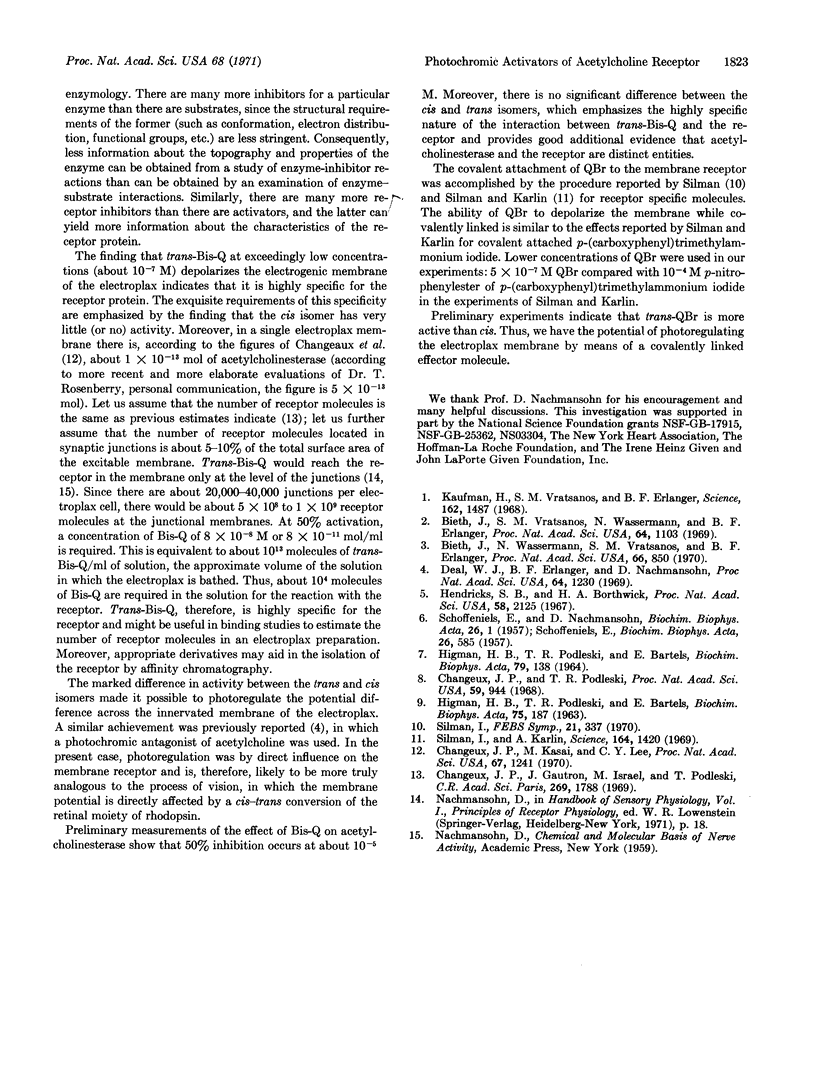Abstract
Two photochromic activators of the electrogenic membrane of the electroplax of Electrophorus electricus are described. Trans-3,3′-bis[α-(trimethylammonium)methyl]azobenzene dibromide (Bis-Q), one of the most potent ever reported, is active at concentrations of less than 10-7 M. Its cis isomer, which is obtained from the trans by exposure to light of 330 nm, is practically devoid of activity. Photoregulation of the potential of the membrane takes place in the presence of Bis-Q, presumably because of the conversion of the active trans isomer to the inactive cis isomer in the single-cell electroplax system. The second activator, 3-(α-bromomethyl)-3′-[α-(trimethylammonium)methyl]azobenzene bromide (QBr) can be covalently attached to the electroplax membrane after reduction of the membrane with dithiothreitol. Activation of the membrane is induced by the covalently linked reagent. Its cis isomer, obtained from the trans by exposure to light of 330 nm, is, like cis-Bis-Q, of very low activity. Both isomers of Bis-Q are equally active as inhibitors of acetylcholinesterase, 50% inhibition occurring at a concentration of 10-5 M. The possibility of using trans-Bis-Q and trans-QBr to characterize and isolate the receptor protein is discussed.
Keywords: Electrophorus electricus electroplax, membrane potential, photoregulation, vision
Full text
PDF



Selected References
These references are in PubMed. This may not be the complete list of references from this article.
- Bieth J., Vratsanos S. M., Wassermann N., Erlanger B. F. Photoregulation of biological activity by photocromic reagents. II. Inhibitors of acetylcholinesterase. Proc Natl Acad Sci U S A. 1969 Nov;64(3):1103–1106. doi: 10.1073/pnas.64.3.1103. [DOI] [PMC free article] [PubMed] [Google Scholar]
- Bieth J., Wassermann N., Vratsanos S. M., Erlanger B. F. Photoregulation of biological activity by photochromic reagents, IV. A model for diurnal variation of enzymic activity. Proc Natl Acad Sci U S A. 1970 Jul;66(3):850–854. doi: 10.1073/pnas.66.3.850. [DOI] [PMC free article] [PubMed] [Google Scholar]
- Changeux J. P., Gautron J., Israël M., Podleski T. Séparation de membranes excitables à partir de l'organe électrique d'Electrophorus electricus. C R Acad Sci Hebd Seances Acad Sci D. 1969 Nov 3;269(18):1788–1791. [PubMed] [Google Scholar]
- Changeux J. P., Kasai M., Lee C. Y. Use of a snake venom toxin to characterize the cholinergic receptor protein. Proc Natl Acad Sci U S A. 1970 Nov;67(3):1241–1247. doi: 10.1073/pnas.67.3.1241. [DOI] [PMC free article] [PubMed] [Google Scholar]
- Changeux J. P., Podleski T. R. On the excitability and cooperativity of the electroplax membrane. Proc Natl Acad Sci U S A. 1968 Mar;59(3):944–950. doi: 10.1073/pnas.59.3.944. [DOI] [PMC free article] [PubMed] [Google Scholar]
- Deal W. J., Erlanger B. F., Nachmansohn D. Photoregulation of biological activity by photochromic reagents. 3. Photoregulation of bioelectricity by acetylcholine receptor inhibitors. Proc Natl Acad Sci U S A. 1969 Dec;64(4):1230–1234. doi: 10.1073/pnas.64.4.1230. [DOI] [PMC free article] [PubMed] [Google Scholar]
- HIGMAN H. B., PODLESKI T. R., BARTELS E. APPARENT DISSOCIATION CONSTANTS BETWEEN CARBAMYLCHOLINE, DELTA-TUBOCURARINE AND THE RECEPTOR. Biochim Biophys Acta. 1963 Sep 24;75:187–193. doi: 10.1016/0006-3002(63)90597-3. [DOI] [PubMed] [Google Scholar]
- HIGMAN H. B., PODLESKI T. R., BARTELS E. CORRELATION OF MEMBRANE POTENTIAL AND POTASSIUM FLUX IN THE ELECTROPLAX OF ELECTROPHORUS. Biochim Biophys Acta. 1964 Jan 27;79:138–150. doi: 10.1016/0926-6577(64)90047-6. [DOI] [PubMed] [Google Scholar]
- Hendricks S. B., Borthwick H. A. The function of phytochrome in regulation of plant growth. Proc Natl Acad Sci U S A. 1967 Nov;58(5):2125–2130. doi: 10.1073/pnas.58.5.2125. [DOI] [PMC free article] [PubMed] [Google Scholar]
- Kaufman H., Vratsanos S. M., Erlanger B. F. Photoregulation of an enzymic process by means of a light-sensitive ligand. Science. 1968 Dec 27;162(3861):1487–1489. doi: 10.1126/science.162.3861.1487. [DOI] [PubMed] [Google Scholar]
- SCHOFFENIELS E. An isolated single electroplax preparation. II. Improved preparation for studying ion flux. Biochim Biophys Acta. 1957 Dec;26(3):585–596. doi: 10.1016/0006-3002(57)90106-3. [DOI] [PubMed] [Google Scholar]
- SCHOFFENIELS E., NACHMANSOHN D. An isolated single electroplax preparation. I. New data on the effect of acetylcholine and related compounds. Biochim Biophys Acta. 1957 Oct;26(1):1–15. doi: 10.1016/0006-3002(57)90047-1. [DOI] [PubMed] [Google Scholar]
- Silman I., Karlin A. Acetylcholine receptor: covalent attachment of depolarizing groups at the active site. Science. 1969 Jun 20;164(3886):1420–1421. doi: 10.1126/science.164.3886.1420. [DOI] [PubMed] [Google Scholar]


